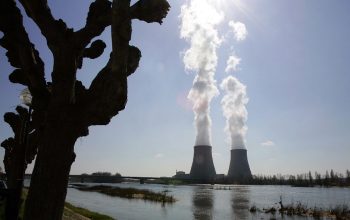
The European Union will aim to have 40% of the key technology it needs to combat climate change built within its own borders by 2030.
The goal is the centrepiece of a new strategy designed to boost domestic industry and cut dependencies on foreign suppliers, mainly China, a country that enjoys a vastly comfortable lead in the production of batteries, solar panels and wind turbines.
The strategy is also a response to the Inflation Reduction Act (IRA) passed last year by US President Joe Biden. The IRA includes a $369-billion envelope of tax credits and direct rebates to promote investment in green technology, but only if these products are predominately manufactured in North America.
The generous injection of American money sent Brussels policymakers into a panic, resulting in a new industrial strategy designed in record time.
Competitiveness is the leitmotiv underpinning the latest plans, which were unveiled on Thursday by the European Commission under the name “Net-Zero Industry Act.”
The act identifies eight sectors as being “strategic” for the EU in both the short and long term: solar, wind, batteries, heat pumps and geothermal energy, electrolysers to produce hydrogen, sustainable biogas and biomethane, carbon capture and storage, and power grids.
These “strategic projects” should be granted faster administrative and permitting rules, from 9 to 12 months compared to 12 to 18 months without the special designation. If necessary, these projects could also override considerations of public interest related to environmental protection, a provision environmental NGOs including WWF have already decried.
The selected sectors will also benefit from a set of relaxed subsidy rules unveiled last week.
This preferential treatment, the Commission says, should lure in investors and accelerate the deployment of green technologies, which are indispensable to phase out fossil fuels and achieve climate neutrality by mid-century.
But the approach proposed by Brussels, in which member states will effectively hand-pick some industries to the detriment of others, has fuelled accusations of protectionism and dirigisme, two ideologies that run counter to the free-market principles the EU has long defended.
Frans Timmermans, the European Commission’s vice-president in charge of the Green Deal, dismissed such accusations and also rejected comparisons with China, where the Communist Party shapes the economy and sets growth targets through five-year plans.
“The one mistake I think we’ve made, and the one mistake that would be old-fashioned in industry politics would be to have no industry politics. And that’s what we had for too long in Europe, thinking that the market would take care of everything itself,” Timmermans told reporters.
“So this what we’re doing is forward-looking, not old-fashioned. It’s what you need to do when you’re in the middle of an industrial revolution.”
Although the strategy does not include nuclear energy under the list of “strategic projects,” it does say that “advanced technologies to produce energy from nuclear processes with minimal waste” and “small modular reactors” could be supported by national governments.
The role of nuclear in the EU’s green transition has been the subject of enormous controversy and has divided member states into seemingly irreconcilable pro- and anti-nuclear factions.
Thierry Breton, the European Commissioner for the internal market, who hails from France, said it was the time to “go beyond ideologies” and “relaunch” Europe’s nuclear sector.
“The data is there. Without nuclear, there is no strategic autonomy and no contribution to climate efforts,” Breton said. “It is also, let’s face it, a technology in which the risk of loss of know-how is real.”
The draft plans are intricate and represent a quantum leap for the European Commission, which for decades struggled to come up with a long-term industrial policy, an area where it has limited competences and that has traditionally been the domain of member states.
The “Net-Zero Industry Act” will be up for a first exchange of views when EU leaders meet in Brussels next week for a two-day summit. After that, the texts that enshrine the production targets in law will be negotiated by the EU Council and the European Parliament before entering into force.
For Domien Vangenechten, a senior policy advisor at the E3G think tank, the Commission’s proposal has a stronger industrial, rather than green, flavour to it.
“It reads more like competition policy or an economic policy,” Vangenechten told Euronews.
“Obviously, it has a green element to it. We’re talking about manufacturing capacity for those technologies that are crucial for the net-zero transition. I’m missing sort of the next step”.

